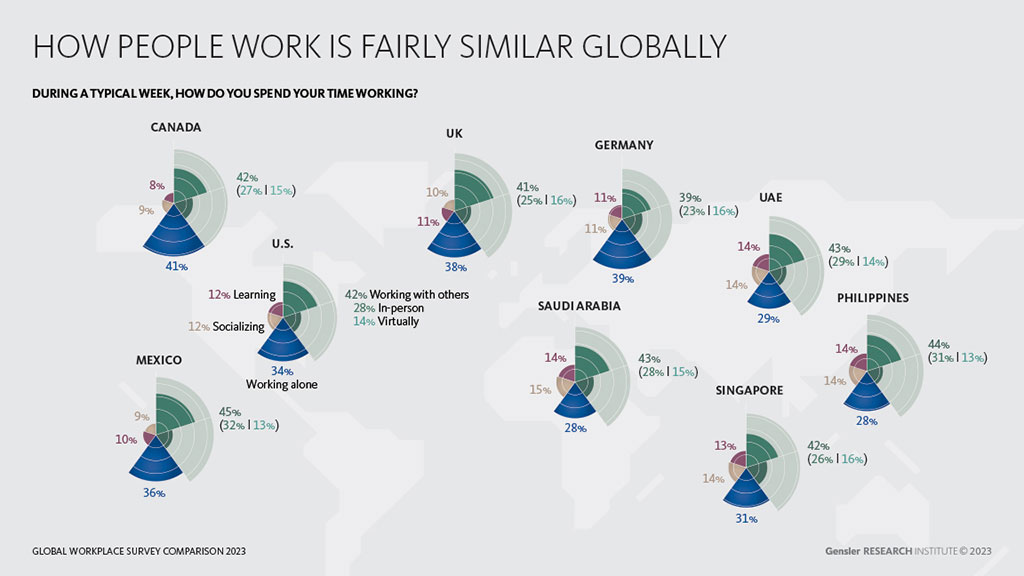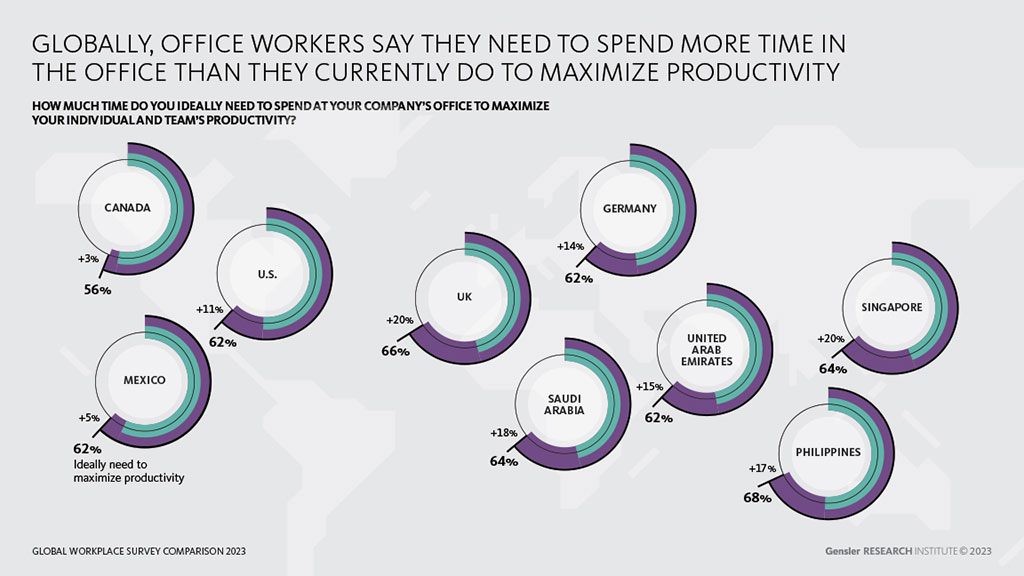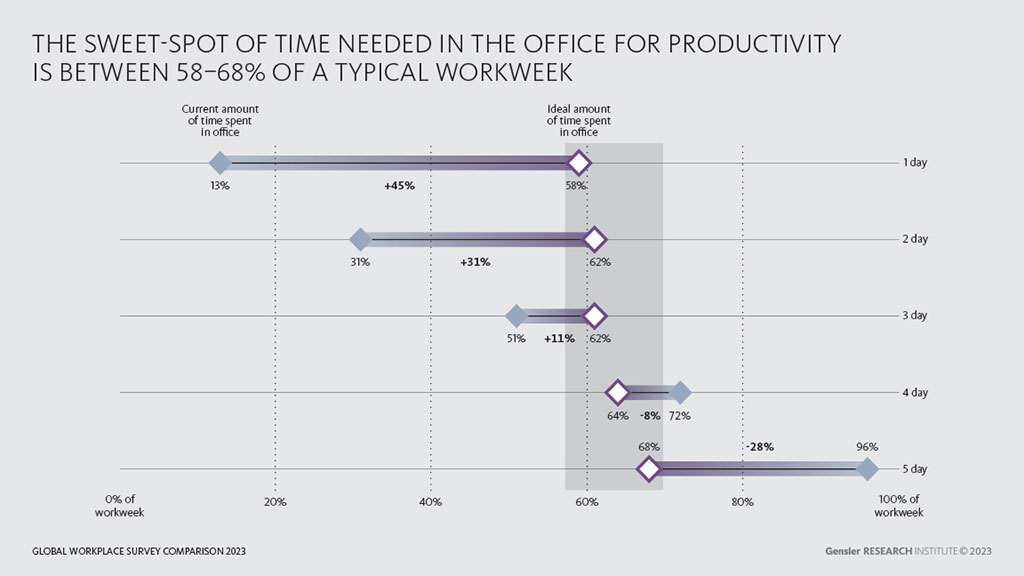Hybrid Is Here to Stay. So Is the Office.
June 13, 2023 | By Janet Pogue McLaurin and Anita Grabowska
Office buildings in many cities are sitting empty, with some cities reporting the highest vacancies ever recorded. At the same time, Kastle is measuring average occupancy at just under 50% across 10 key U.S. cities. Does this paint a picture of doom and gloom for the office? In Gensler’s latest workplace research of 14,000 office workers across 10 industries in nine countries, we found an optimistic future emerging: while hybrid work is here to stay, the office is needed more than ever. And we found a few other surprises as well.
Gensler has been measuring how people work, space effectiveness, and what employees value in a workplace experience since 2005. With our data, we can see what is changing over time as well as identify global commonalities and unique differences by country, by industry, and by key performance indicators such as innovation, commitment, and engagement. As employees were returning to the office in late summer and fall of 2022, we researched how and where people were working, why people were going to the office, what’s working/not, and what’s missing. In the process, we uncovered some interesting shifts in how people are working and their expectations for the workplace moving forward. This is the first of a blog series delving into some of the key findings. Check out the published report here.
How we work has shifted — and it’s surprisingly similar around the globe.
Gensler has been measuring how people work during a typical work week by five key work modes: working alone, working with others in-person, working with others virtually, learning, and socializing. This is not time spent at the office, but the total percentage of time for the week, regardless of where the work is performed. Since the pandemic, we have seen time spent learning and socializing double in the U.S., as well as in the U.K., where we have been monitoring how people work since 2008. Time spent working alone has steadily fallen over the years from roughly 50% to 35% of a typical week. Time spent working with others (both virtually and in-person) is now the largest work mode, totaling a global average of 45% of a typical week. The distinction between working with others in-person and virtual is not always so clear, as hybrid meetings now make up 57% of meetings held in the office.
For a number of countries in our latest survey, it was the first time we had conducted a workplace survey; however, we found that workers in each country have surprisingly similar work styles. There are subtle differences, with workers in Canada and Mexico spending the most amount of time working alone and those in Saudi Arabia and the Philippines spending the least. Workers in Southeast Asia, the Middle East, and the U.S. spend more time learning and socializing than in the other countries; however, the total time spent working with others was again remarkably similar.

There is a gap between current office utilization and what employees say they need.
We also measured where work is currently occurring. “Hybrid” is a relatively new word, but the concept of mobility is not — we’ve always worked both in and out of the office. U.S. employees say they worked about 80% on average at their company’s primary office, while workers at the most innovative companies spent even more time out of the office — back to the 67% of the workweek we measured right before the pandemic. We saw a similar pattern in other countries at the time. In our latest research, global office workers report that they are currently spending 50% of their workweek at their company’s office, and the most innovative spend slightly less. Working from home was only 20% of the week; the balance was spent at client/customer sites, other office or coworking sites, traveling on business, and working from third places, such as coffee shops, libraries, and parks.
But then we asked two very interesting questions: how much time do you ideally need to spend at your company’s office to maximize your individual productivity, and how much time do you ideally need to maximize your team’s productivity? Our hypothesis was that workers may need the office for their team’s productivity and need to work from home for their individual productivity; however, the findings revealed a big surprise: people need the office to maximize both their individual and team productivity equally. And globally, workers said they need an average of 63% of the workweek at the office to maximize their productivity. That’s a big gap between current utilization and what people feel they need. There was a variation by country, but every country saw a gap increase. The largest increase was 20% for both the U.K. and Singapore, followed by a 18% and 17% increase in Saudi Arabia and the Philippines, respectively. Canada had the smallest gap at just 3%.

If office workers around the globe feel they need the office to maximize their productivity, then why aren’t they coming into the office more often? What is holding people back? What would make people willing to come in more often? Excluding full-time office workers, we found that a different mix of experiences would make 80% of global office workers willing to come to the office more often. On average, 42% report that they would return one more day/week and 25% report that they would return full-time for their ideal mix of experiences.
There is a “sweet spot” of time needed in the office for productivity.
Across all nine countries surveyed, 61% of respondents said they need to spend more time in the office to maximize their productivity. About a third (34%) say they need the office less than they are currently utilizing and 5% say their current use is the same as their ideal need. Those that say they need the office most tend to spend two-thirds of their time working in locations outside the office, while those who need the office less spend three-quarters of the workweek at the office on average.
As we continued to analyze the data by utilization and by country, we uncovered an interesting pattern: the amount of time needed for the office varies depending upon the amount of time that people are currently spending working there. We segmented the data into 20% chunks of the week, roughly equating with days of the week. The most mobile, out-of-the-office employees report that they need to spend far more time in their company’s workplace, while full-time office workers need significantly less time than they are currently spending. In other words, those employees coming into the office more than 63% of the workweek report they need less time, and those at the office less need it more. Looking at the full spectrum, the ‘sweet spot’ to maximize productivity is between 58% to 68% of a typical workweek at the office.

It’s time for the workplace to meet the moment.
Work has changed. People have a new awareness of how they work best, the types of spaces they need, and the types of experiences that they can’t get working remotely. Employees intuitively know that the office is needed to maximize their productivity. In fact, 61% of respondents report that they need more time in the office. Despite the rise of remote and hybrid work models, the office remains a critical space for many knowledge workers to perform at their best. Yet, the physical workplace hasn’t kept pace — nearly two-thirds of workplaces have not changed since the pandemic.
It’s time for the physical work environment to respond. Now more than ever, workers need the office as a place to come together and get work done. Employers should invest in workplaces that not only help people work better but also provide workplace experiences that bring their employees into the office more often, making the office a compelling destination rather than an obligation.
For media inquiries, email .


